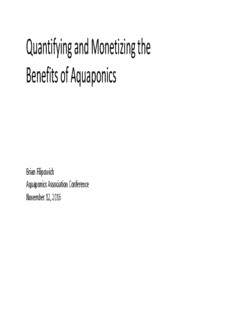
Quantifying and Monetizing the Benefits of Aquaponics PDF
Preview Quantifying and Monetizing the Benefits of Aquaponics
Quantifying and Monetizing the Benefits of Aquaponics Brian Filipowich Aquaponics Association Conference November 12, 2016 Quantifying and Monetizing the Benefits of Aquaponics Goals of this presentation: • Build a critical mass of aquaponic growers that understand: • how True Cost Accounting reveals the economic benefit of aquaponics • That the hidden costs of modern industrial agriculture are public problems that require public policy to address • Galvanize aquaponic growers to begin educating the public, the media, and policy-makers about the economic benefits of aquaponics • Start the campaign for local, state, and federal policy changes that help aquaponic growers monetize our benefits Contents • Economic Basics • The Price of a Head of Lettuce • Externalities / Hidden Costs in Our Modern Agriculture System • Who Ends Up Paying for these Hidden Costs? • Accounting for the Aquaponics Advantage • The BIG QUESTION! • The Price of Aquaponics Lettuce vs Industrial Agriculture Lettuce • How Can Aquaponics Monetize its Benefits? • Bad News, Public Policy Required • Good News, Efforts Are Underway • The 2018 Farm Bill Economic Basics –The Price of a Head of Lettuce Producers sell their products for a price that accounts for the cost of inputs and production, plus a profit margin. Hypothetical Cost of a Head of Lettuce - $3.00 $3.00 Profit = $0.50 At the Market, a consumer pays $3.00 for this head of Delivery to Market - $0.50 lettuce. The $3.00 pays for the production costs and Paying Employees - $1.00 inputs, plus some profit for the producer. Land, Seeds, Taxes, etc - $1.00 Economic Basics –Externalities / Hidden Costs in Our Modern Agriculture System Flaw in the System What if some of the costs of production aren’t paid for? For example: what if some costs don’t materialize until AFTER the consumer’s purchase and consumption of the good? ….Uh-oh Externalities, a technical name for “Hidden Costs” “An externality is a consequence of an economic activity experienced by unrelated third parties; it can be either positive or negative.” http://www.investopedia.com/terms/e/externality.asp Economic Basics –Externalities / Hidden Costs in Our Modern Agriculture System Negative Externality Example Pollution from a nearby factory can tarnish the surrounding environment and affect the health of nearby residents. This pollution will lead to increased healthcare costs, decreased property value, and other costs that are paid for by unrelated 3rd parties, rather than by the producer / consumer of the good that caused the pollution. Positive Externality Example When you pay for your own college degree you get a private benefit. But there are also benefits to the rest of society, such as a better economy and reduced crime rate. These factors are economically beneficial for society as a whole, even though they didn’t pay for your college degree. Economic Basics –Externalities / Hidden Costs in Our Modern Agriculture System Our Modern Agricultural System is LOADED with Hidden Costs • Extreme Water Usage • Carbon Emissions / Climate Change • Pesticide Usage • Antibiotic Usage • Fertilizer Usage / Nutrient Runoff • Soil Compaction and Erosion • Excessive Land Use / Biodiversity Loss Economic Basics –Externalities / Hidden Costs in Our Modern Agriculture System “True Cost Accounting” The process by which the full costs and benefits of different food and farming systems are identified, quantified and made transparent with the aim of ensuring that in future these are fully reflected in the cost of production for farmers. Economics –Who Ends Up Paying for these Hidden Costs? Example #1 of a Hidden Cost in our Agricultural System Fertilizer Runoff from Farms Nitrogen and Phosphorus runoff from farm fertilizers is a major cause of pollution. “Both nitrogen and phosphorus feed algal blooms that block sunlight to underwater grasses and suck up life supporting oxygen when they die and decompose. These resulting "dead zones" of low or no oxygen can stress and even kill fish and shellfish. Algal blooms can also trigger spikes in pH levels, stressing fish, and create conditions that spur the growth of parasites. Toxic algae, such as some blue-green algae (cyanobacteria), can sicken people, as well, but animals are especially susceptible. These toxins affect the animal's liver and nervous system, and can result in death.” (http://www.cbf.org/about-the-bay/issues/dead-zones/nitrogen-phosphorus) The largest source of pollution to the Bay comes from agricultural runoff, which contributes roughly 40 percent of the nitrogen and 50 percent of the phosphorus entering the Chesapeake Bay. (http://www.dailypress.com/news/science/dp-nws-bay-dead-zone-20160615-story.html) Economics –Who Ends Up Paying for these Hidden Costs? Two examples of the hidden costs of farm fertilizer runoff The National Oceanic and Atmospheric Administration estimates that the dead zone in the Gulf of Mexico costs U.S. seafood and tourism industries $82 $82 million a year. million/yr (http://www.nature.org/ourinitiatives/regions/northamerica/areas/gulfofmexico/explore/gulf-of-mexico-dead-zone.xml) The Chesapeake Bay Commission estimates that it will cost $18.7 $18.7 Billion for an eight year effort to completely clean the Bay. BILLION Total (http://www.chesbay.us/Publications/C2Kfunding.pdf)
Description: